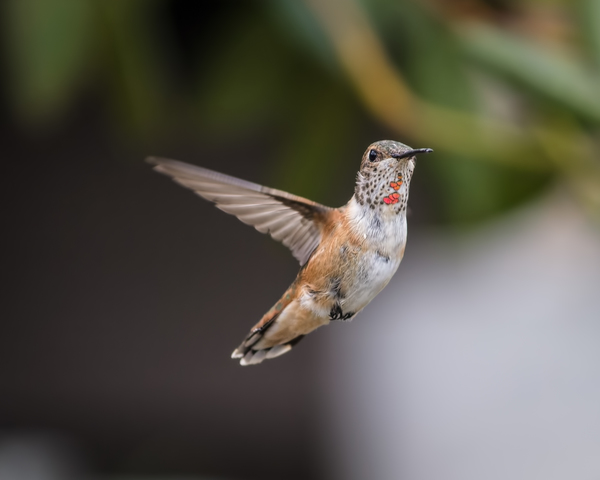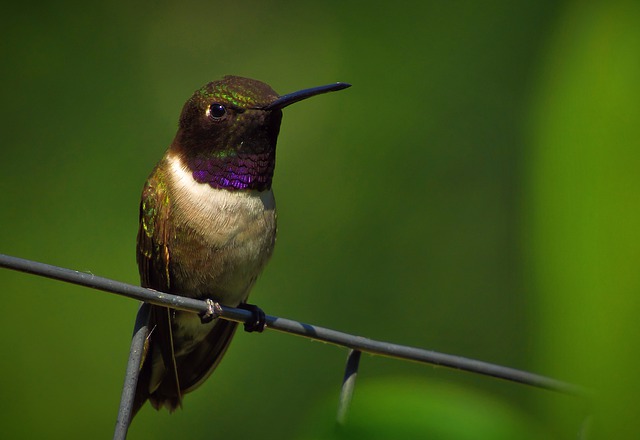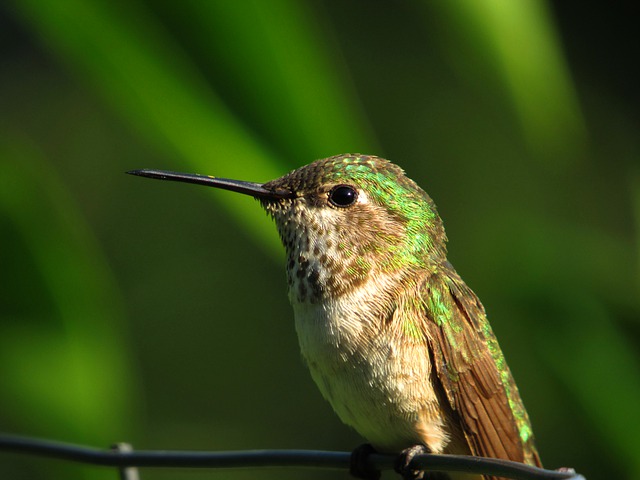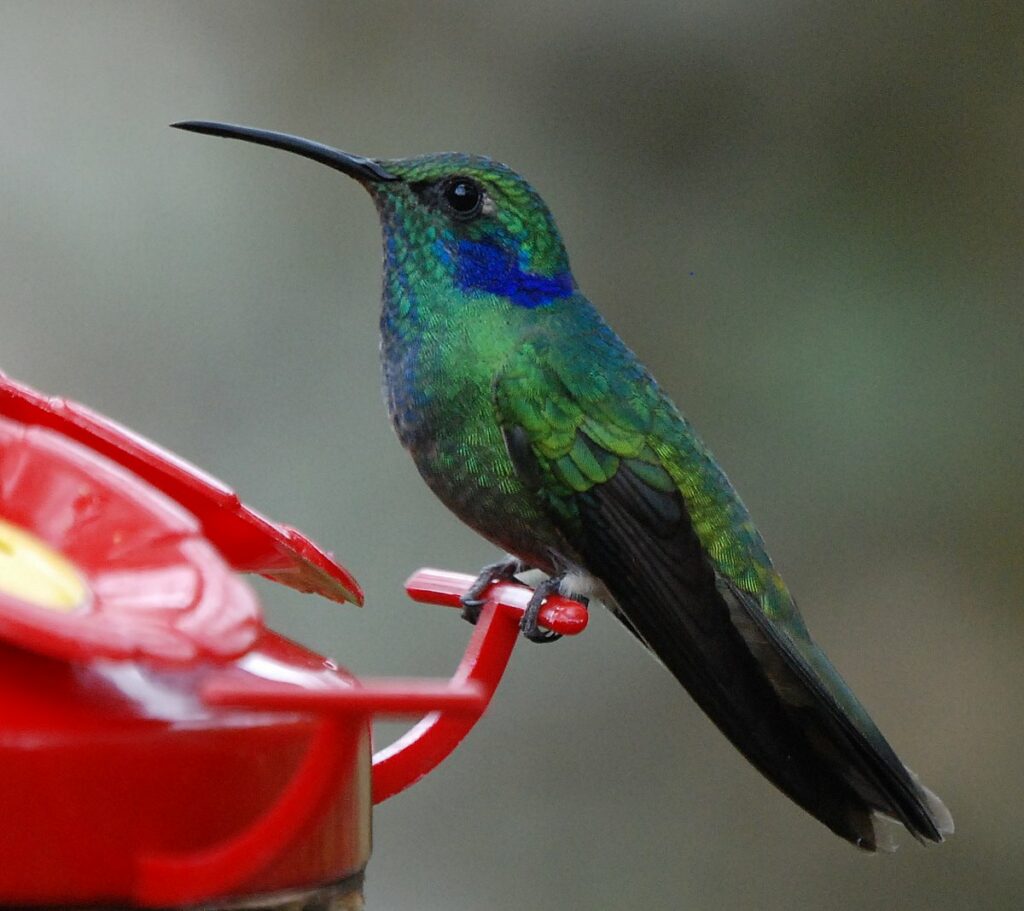Are you ready to discover the buzzing beauty that is hummingbirds?
If you live in Indiana, you might be surprised to learn that there are not just one or two, but seven different types of these tiny, fast-moving birds that call your state home.
From the striking ruby-throated hummingbird to the lesser-known rufous hummingbird, each species has its own unique characteristics and charm.
So, grab a pair of binoculars and get ready to explore the world of Indiana’s hummingbirds!
| Image | |
|---|---|
 | Ruby-throated Hummingbird |
 | Anna's Hummingbird |
 | Rufous Hummingbird |
 | Black-chinned Hummingbird |
 | Calliope Hummingbird |
 | Mexican Violetear |
Types of Hummingbirds in Indiana
1. Ruby-throated Hummingbird

During the summer season, 23% of Indiana lists include the Ruby-throated Hummingbird as the most commonly seen hummingbird across the state.
Most often spotted between the months of May to September, but sometimes arriving as early as March and staying till December, they spend the mating season in the state.
The male Ruby-throated Hummingbirds possess quite an intense red neck and a gray-white upperside.
Green on top and white below, with brown sides and crowns, female Ruby-throated Hummingbirds have a distinctive green neck.
Throughout all of eastern North America, the Ruby-throated Hummingbird represents the only hummingbird that nests.
After that, they go even farther south, towards Central America, to spend the winter season.
The route used by some migrants is across the Gulf of Mexico, while others go around the Texas coast.
The first ruby-throated hummingbirds come there in the United States around February; however, they may not reach the northern states and Canada before May.
The males often arrive 1 to 2 weeks just before females in the springtime.
In preparation for their wintering grounds, Ruby-throated Hummingbirds begin their annual migration south in August and September, congregating near the Texas Gulf Coast around September.
These little birds dart from flower to flower in search of nectar, or they swoop down from the sky to pluck insects from the air or out of spider webs.
Short legs prevent them from walking; therefore, instead of walking, they shuffle along a perch, sometimes pausing to rest on a twig.
The ideal locations to look for them in the summertime are flower yards and the outskirts of wooded areas.
They may also be seen in large numbers at nectar feeders in urban areas.
When defending their territory, male Ruby-throated Hummingbirds may be rather violent.
After breeding, males often go quickly, sometimes leaving as early as the first week of August.
The nests of the ruby-throated female are made of thistle or dandelion down and bound together with spider silk, and they are placed on very thin twigs.
A clutch may consist of anything from one to three eggs, each of which measures only 0.8 inches.
2. Anna’s Hummingbird

Anna’s Hummingbirds are mostly seen in highlands in the state’s far northwest.
Little birds, known as Anna’s Hummingbirds, are generally green and gray in color.
The male possesses a shiny sheen on their head and throat.
The female possesses a grey neck with a few red spots here and there.
Anna’s Hummingbirds are the most common species, mostly along Pacific Coast, because they do not migrate.
They spend the autumn and spring months everywhere, from Baja California through British Columbia.
Nonetheless, it’s possible that some bird species will make a winter migration from the far north beyond their habitat.
Anna’s hummingbirds may be encountered in a variety of environments, including gardens and parkland with many nectar feeders and flowering plants, as well as scrub and savannah.
Anna’s hummingbirds consume nectar, spiders, tree sap, and tiny insects.
Eucalyptus trees, Diplaucus, Agaves, Arctostaphylos, Nicotiana plants, Castillejas, Silena, Ribes, and nectar-feeding insects that make nectar.
The nests of Anna’s Hummingbirds are typically located 5 to 21 feet on top of trees, and the female bird does all of the labor, despite the fact that she may have 2 or 4 broods every year.
During courting, the males will soar approximately 135 feet in the air and then plummet back down with a sonic boom from their tail plumes.
3. Rufous Hummingbird

In 2022, a Rufous Hummingbird was observed nearby Perry, Indiana, despite the fact that this species is listed as “near-threatened” in the state of Indiana.
Both the back and abdomen of a Rufous Hummingbird are a brilliant orange color, while the bird’s underside is white, and its neck is iridescent crimson in males.
The females have a bluish- a white abdomen, greenback, and rusty sides.
When compared to their size, Rufous Hummingbirds are among the greatest migration distances.
They spend the summertime breeding in far northern Canada and Alaska and the winter around the Gulf Coast and Mexico.
In the springtime, Rufous Hummingbirds fly along the Pacific Coast, and in the autumn, they cross the Rocky Mountains. Beginning in February, the spring migration of Rufous Hummingbirds often reaches Alaska before mid-April.
October marks the conclusion of the autumn migration season, which begins in July and August.
According to research, rufous hummingbirds now begin their annual migration to the north early and go further inland.
Since the 1970s, the Rufous Hummingbird population has dropped by an estimated 60%.
Nectar from bright small insects and tubular flowers like flies, gnats, and midges make up the majority of a Rufous Hummingbird’s diet.
The soft down of plants and spider webs is used to construct the nest, which is placed in a tree’s upper reaches.
Two to three small white eggs, measuring approximately 0.5 inches (1.3 centimeters), are laid.
Mountains and coniferous woods are their natural environment.
They are quite hostile, driving away even bigger hummingbirds and resident hummingbirds when they emerge.
While they don’t stick around for long, they might drive away other hummingbirds if given the opportunity during migration.
4. Black-chinned Hummingbird

Indiana’s Black-chinned birds have become an endangered species; the last one was seen at Hidden Valley Lake in 2021.
On the outside, Black-chinned specie is a dreary metallic greenish, while on the inside, they are a drab gray-white.
When seen from above, the male has a black throat with a small shiny purplish base, while the female has a pale neck and white points on the tail plumes.
From Baja California through British Columbia, these hummingbirds spend the summer season breeding mostly in inland regions.
After they have completed courting, they might head toward the highlands, searching for more blossoms, before beginning the long trek south, where they’ll stay in cold weather across the Gulf Coast, western Mexico, or southern California.
It is common for Black-chinned Hummingbirds to migrate between April and September.
When they are feeding on nectar, they are able to lick their tongues between 13 to 16 times every single second.
In addition to nectar, their diet also consists of spiders and other small insects.
Black-chinned specie builds their 0.9-inch-tall nests from the plant down and spider web, and they deposit two small white eggs (1.35 cm).
Black-chinned specie usually revisits the same place at the apex of felled trees, in which they perch on bare, small twigs.
Along canyon walls, along riverbeds, and behind shade oaks, you’ll find them.
5. Calliope Hummingbird

The Calliope Hummingbird, which is the tiniest bird in the United States and is about the size of a ping-pong ball, able to migrate over 5,100 miles yearly, all the way from Mexico through Canada and back again.
It is the tiniest bird in the country.
They are also very capable of guarding their area and have been reported to go after Red-shoulder Hawks.
The male Calliope specie possesses shiny green backs and sides, brilliant magenta throats (also referred to as the gorget), and blackish tails.
Females do not have the iridescent throats seen on males and have a more pinkish-white underside as opposed to the white that males have.
Calliope Hummingbirds’ spring migratory is through the Rocky Mountains, mostly along Pacific Coast, to nesting regions across California, Colorado, and up to northern states, British Columbia, Vancouver Island, and Alberta.
They begin their journey north pretty early in February and will arrive in Canada between the middle of April and the beginning of May.
Migration in the fall takes place along the Rocky Mountains towards wintering grounds, mostly in the southwestern United States, but perhaps more lately, it has also begun to occur along the Gulf Coast around August and into September.
Nests are often built on coniferous forests, and birds might reuse existing nests or construct new ones on top of older ones.
7. Mexican Violetear

Accidental species, sometimes known as Mexican Violetears, may be found in Indiana, although sightings of these are relatively uncommon across the state.
In point of fact, they were seen only once, and that was in the year 2011.
Metallic green in color, Mexican Violetears are about the size of other medium-sized hummingbirds and have violet spots on the sides of their forehead and on their chests.
Breeding grounds for Mexican Violetears are located in the forested regions of Mexico, Central America, and even as far south as Nicaragua; nevertheless, the species has been seen in the mountainous regions of Venezuela and Bolivia.
Additionally, non-breeding Mexican Violetears might cross the border into southern and central Texas, mostly in the United States, and spend the winter there.
Conclusion
In conclusion, Indiana’s seven species of hummingbirds offer a delightful and awe-inspiring display of nature’s beauty.
Despite their small size, these birds are full of character and personality, each with their own distinct coloring, behavior, and migration patterns.
Whether you’re an avid bird-watcher or simply enjoy the occasional glimpse of these enchanting creatures, exploring the hummingbirds of Indiana is a rewarding experience.
So, the next time you spot a flash of iridescent colors flitting by, take a moment to appreciate the wonder of these remarkable birds and the diversity of life that surrounds us.
FAQ
What is the smallest hummingbird species in Indiana?
The Ruby-throated Hummingbird is the smallest species of hummingbird found in Indiana, measuring only 3 to 3.5 inches in length.
What is the largest hummingbird species in Indiana?
The Ruby-throated Hummingbird is also the largest species of hummingbird found in Indiana, although it is still very small compared to other bird species.
When can hummingbirds be seen in Indiana?
Hummingbirds usually arrive in Indiana in mid-April and stay until early October. The peak of hummingbird activity in Indiana is during the summer months of June, July, and August.
What type of flowers attract hummingbirds in Indiana?
Hummingbirds are attracted to brightly colored flowers with tubular shapes, such as trumpet vine, bee balm, cardinal flower, and salvia.
Are hummingbirds migratory birds?
Yes, hummingbirds are migratory birds. Most species of hummingbirds that breed in North America spend the winter months in Central and South America.
Last Updated on March 22, 2023 by Lily Aldrin
